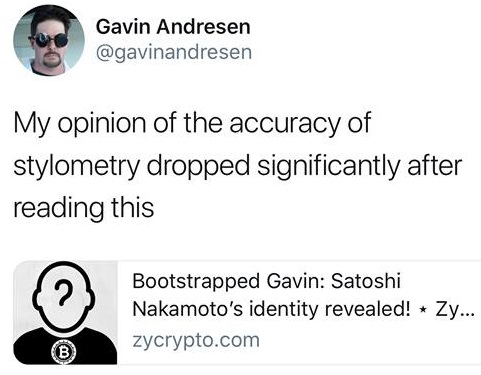Latest news about Bitcoin and all cryptocurrencies. Your daily crypto news habit.

Self-described informative and interactive crypto website, Zy Crypto, a nonprofit based in England, believes it has struck ecosystem gold by discovering Satoshi Nakamoto’s real identity. It’s the second attempt by the outfit, and both times they’ve relied upon stylometry before concluding that Bitcoin Cash developer Gavin Andresen is Satoshi hiding in plain sight. This go-round analysis involves not only statistical analysis of prose, but also Maciej Eder’s bootstrapping method in an attempt to eliminate natural bias in such conclusions.
Also read: Apple Sides with Russian Govt, Restricts Telegram, Claims Pavel Durov
Bitcoin Cash Developer Gavin Andresen Is the Real Satoshi Nakamoto
Two upfront admittances, if readers indulge. The first is, I am a Troy Watson fan. I enjoy his work, and count myself as someone who approves of his earnest dive into such subjects. Second, I have probably read more about the present pseudonym under examination than is healthy, and not just because I make my living in the space. Flatly, I am obsessed. No clickbait here, or not intentionally. No hype. This is a fun pursuit, and one worth some effort as it involves cryptocurrency’s origin story.
Zy Crypto is a curious little outfit based in a lesser-known part of the United Kingdom. They’ve the site proper, a news aggregation service, and what appear to be variations on the public relations themes of initial coin offerings and blockchains. To publish one, let alone two articles asserting both times how Bitcoin Cash developer Gavin Andresen is Satoshi, for once and for all, speaks volumes about either the confidence Zy has in its writer or the fact they’re sporting for clicks.
Consider this sentence, hitting readers right between the eyes: “We identified Bitcoin Cash developer Gavin Andresen as being the real Satoshi Nakamoto,” Mr. Watson boldly asserts before an immediate pivot towards technique. The primary methodology used in both examinations is what’s known as stylometry. It’s the study of prose put up against other writers as a way of determining patterns and is an actual predictive of authorship when done well.
Stylometry has picked up in recent years as an investigative tool when faced with the spectre of Satoshi Nakamoto. The pseudo anonymous creator of Bitcoin holds more than five percent of bitcoin in circulation, making him the first crypto billionaire. Should Mr. Nakamoto decide for shits and giggles to dump a significant amount of coin onto the market, not only would the price drop by virtue of economic law, confidence would probably crash as well, bringing down a giant chunk of whatever value bitcoin has. It’s a big goddamn deal who Satoshi is.
Stylometry’s False Positives or Conclusive Hits
The technology to out a writer wishing to remain in has proven its worth. In the mid 1960s, Frederick Mosteller used stylometry to establish authorship of the hotly contested Federalist Papers, determining James Madison as their probable main author (instead of Alexander Hamilton). It took him almost half a decade, whereas today software exists to run such analysis pretty fast. More famously, and recently, no less an author than zillion-selling Harry Potter creator JK Rowling was found to be the actual author of The Cuckoo’s Calling. A few years ago she wished to have her writing evaluated on its own merits, and so Ms. Rowling took a pen name. Stylometry outed her.
And Zy Crypto isn’t the first to attempt applying the statistical method to Satoshi’s true identity. As bitcoin’s price began to skyrocket, so did interest in who its creator might’ve been. During Craig Wright’s supremely odd public display, outed by supposed hackers, claiming to be Satoshi and then suggesting it was a hoax, a couple of once well-regarded tech journals believed Mr. Wright to be Satoshi. International Business Times employed the very firm used to blow Ms. Rowling’s cover, Juola & Associates. They soon determined what most in the know suspected: Mr. Wright wasn’t bitcoin’s father (he’d respond that he and partner David Kleiman collaborated on the project, but even that has been posthumously tainted). He managed to fool or convince or onboard original Bitcoin dev Gavin Andresen, who went so far as to record video testimony (Vitalik Buterin, Ethereum genius, weighed in on the noise of the matter, and later just outright spat fraud in Mr. Wright’s direction).
Late 2017, price fever pitch reached maximum overdrive, and Michael Chon took his own swing at discovery. The Georgetown University and Booz Allen Hamilton alum concluded Satoshi was a group of devs, with some authoring the whitepaper while others engaged in email exchanges. He narrowed it down to four: “Nick Szabo, Ian Grigg, Wei Dai, and Timothy C. May.” Gavin Andresen wasn’t considered, a subject to which we return.
Mr. Watson details how “using Eder’s bootstrapped stylometry method…this finding supports our previous article on the topic that also identified Gavin as Satoshi using Principal Component Analysis and Burrows’ delta.” Knowing full well the history I’ve outlined above, he concludes, “A big part of this failure can be attributed to the lack of convergence validity in the stylometry field.” And a pitfall within the field itself is how “stylometrics often cherry pick results due to their algorithms producing vastly different results when slightly tweaked,” he acknowledged. This led to suggesting Wei Dai as Satoshi, at least for a time.
Using Stylometry Analysis I Have Discovered I May Be Satoshi Nakamoto
This time, Mr. Watson’s confidence in Mr. Andresen as Satoshi extends from Maciej Eder, who “created a bootstrapping method specifically designed to overcome the problem of cherry picking elements like Most Frequent Words (MFW). The approach uses Burrows’ delta to find a difference between two texts, but also uses random sampling of MFW ranges so as to output more robust results. Burrows’ delta is basically a manhattan distance of z-scores which is sourced from a list of top words used in an entire corpus.”
The rest of the article reads similarly, and the interested would do well with frequent searches of Wikipedia. Nevertheless, he’s “found that the first nearest neighbour was Satoshi’s email texts followed by 3 of Gavin Andresen’s Github documents and then followed by Satoshi’s forum texts. These findings are quite reasonable because not only do they validate the links between the Satoshi whitepaper-emails-forums but they also cluster Gavin as the likely author. It’s also of interest that Gavin’s style was so much like Satoshi’s whitepaper that he beat Satoshi himself with the forum texts!”
Still more discussion of limitations and technical methodology follows, and those without a statistical or mathematical background are cautioned. It’s somewhat like reading French if you don’t speak French. Yeah, there’s the standard Latin alphabet and all, but that’s about as far as most will get. Again, Wikipedia is a friend.I don’t buy it in the end, and have instead relied upon resident ecosystem muckraker, Crypto Cornelius, as my prime response. “I have identified Myself,” he typed in the patois of most these studies, “an amateur crypto enthusiast as being the real Satoshi Nakamoto using Yeder’s bootstrapped Coronary Angiogram stylometry method. This finding supports a previous thought when I woke up one night and thought ‘Could I be Nakamoto?’” Sides splitting, tears dropping on the laptop as I type to you Dear Reader, he continues, “Nano Stylometry was invented by Elon Musk and is a set of methods that aim to identify an unknown author by statistically deciphering their style using statistics, hard to understand graphics and random information.” For geeks like me, good old Cornelius is necessary to bring us back to reality. Happy reading.
Is Gavin the real Satoshi? Let us know in the comments.
Images via the Pixabay, Twitter, giuatt07.
Verify and track bitcoin cash transactions on our BCH Block Explorer, the best of its kind anywhere in the world. Also, keep up with your holdings, BCH and other coins, on our market charts at Satoshi’s Pulse, another original and free service from Bitcoin.com.
Disclaimer
The views and opinions expressed in this article are solely those of the authors and do not reflect the views of Bitcoin Insider. Every investment and trading move involves risk - this is especially true for cryptocurrencies given their volatility. We strongly advise our readers to conduct their own research when making a decision.




